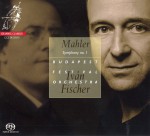
 Mahler – Symphony No.1
Mahler – Symphony No.1
Budapest Festival Orchestra; Ivan Fischer
Channel Classics CCS SA 33112
Mahler – Symphony No.1
Baltimore Symphony Orchestra;
Marin Alsop
Naxos 8.572207
The preliminary version of Gustav Mahler’s First Symphony (described at the time as a Symphonic Poem in five movements) was premiered under the composer’s direction in Budapest in 1889. Its unfamiliar polystylistic collage and inexplicable programmatic elements utterly baffled the audience of the day. Conductor Iván Fischer, in his notes to this new recording with his elite Budapest Festival Orchestra, writes that ever since “at each performance we Hungarians have a moral duty to convince audiences that this is a perfect and exceptionally beautiful masterpiece.” Mission accomplished! This is a performance of remarkable sensitivity, ranging from the intimacy of chamber music to the most powerful, heaven-storming explosions, masterfully recorded in first class studio sound. The dynamic range is exceptionally vivid, tempos are flexible without ever becoming neurotic and the interpretation is thoroughly convincing throughout. The near doubling of the tempo in the closing pages provides a novel and exhilarating conclusion to a truly admirable performance, one of the very best I’ve heard in decades.
Marin Alsop and the Baltimore Symphony paint this score with a much broader brush. In such grandiose music this blunt approach still works marvelously, thanks to the enthusiastic, gritty response from the orchestra and their equally feisty conductor who for the most part seems happy to be carried along with the tide. I take exception however to their use of a recent edition of the score that proposes, on extremely flimsy evidence found not in the score itself but in a set of contested orchestral parts, that the celebrated contrabass solo that so poignantly launches the funereal third movement was intended to be played by the entire bass section. It is known that Mahler evidently tried it this way just once in a rehearsal with the New York Philharmonic in 1909 but quickly abandoned the idea, describing their bass section as “just ONE bass player and seven cobblers!” While these infamously high pitched eight bars (to the tune of the well-known Frére Jacques) have now become standard audition material, to pull such a stunt simply because standards of bass playing have since greatly improved strikes me as a poetic crime of the highest order. I was bothered as well that the recording level has been audibly heightened for this movement, proof positive that the additional basses do not result in a richer tonal experience. This is a generally quite satisfying live performance from quite some time ago (2008), unfortunately marred by notably muddy sound and less than stellar production values.



